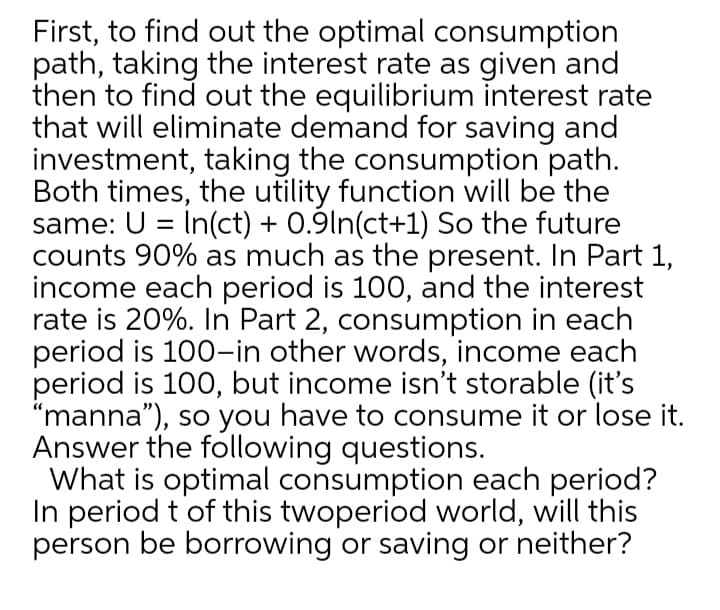First, to find out the optimal consumption path, taking the interest rate as given and then to find out the equilibrium interest rate that will eliminate demand for saving and investment, taking the consumption path. Both times, the utility function will be the same: U = In(ct) + 0.9ln(ct+1) So the future counts 90% as much as the present. In Part 1, income each period is 100, and the interest rate is 20%. In Part 2, consumption in each period is 100-in other words, income each period is 100, but income isn't storable (it's "manna"), so you have to consume it or lose it. Answer the following questions. What is optimal consumption each period? In period t of this twoperiod world, will this person be borrowing or saving or neither?
First, to find out the optimal consumption path, taking the interest rate as given and then to find out the equilibrium interest rate that will eliminate demand for saving and investment, taking the consumption path. Both times, the utility function will be the same: U = In(ct) + 0.9ln(ct+1) So the future counts 90% as much as the present. In Part 1, income each period is 100, and the interest rate is 20%. In Part 2, consumption in each period is 100-in other words, income each period is 100, but income isn't storable (it's "manna"), so you have to consume it or lose it. Answer the following questions. What is optimal consumption each period? In period t of this twoperiod world, will this person be borrowing or saving or neither?
Calculus: Early Transcendentals
8th Edition
ISBN:9781285741550
Author:James Stewart
Publisher:James Stewart
Chapter1: Functions And Models
Section: Chapter Questions
Problem 1RCC: (a) What is a function? What are its domain and range? (b) What is the graph of a function? (c) How...
Related questions
Question

Transcribed Image Text:First, to find out the optimal consumption
path, taking the interest rate as given and
then to find out the equilibrium interest rate
that will eliminate demand for saving and
investment, taking the consumption path.
Both times, the utility function will be the
same: U = In(ct) + 0.9ln(ct+1) So the future
counts 90% as much as the present. In Part 1,
income each period is 100, and the interest
rate is 20%. In Part 2, consumption in each
period is 100-in other words, income each
period is 100, but income isn't storable (it's
"manna"), so you have to consume it or lose it.
Answer the following questions.
What is optimal consumption each period?
In period t of this twoperiod world, will this
person be borrowing or saving or neither?
%3D
Expert Solution
This question has been solved!
Explore an expertly crafted, step-by-step solution for a thorough understanding of key concepts.
Step by step
Solved in 3 steps

Recommended textbooks for you

Calculus: Early Transcendentals
Calculus
ISBN:
9781285741550
Author:
James Stewart
Publisher:
Cengage Learning

Thomas' Calculus (14th Edition)
Calculus
ISBN:
9780134438986
Author:
Joel R. Hass, Christopher E. Heil, Maurice D. Weir
Publisher:
PEARSON

Calculus: Early Transcendentals (3rd Edition)
Calculus
ISBN:
9780134763644
Author:
William L. Briggs, Lyle Cochran, Bernard Gillett, Eric Schulz
Publisher:
PEARSON

Calculus: Early Transcendentals
Calculus
ISBN:
9781285741550
Author:
James Stewart
Publisher:
Cengage Learning

Thomas' Calculus (14th Edition)
Calculus
ISBN:
9780134438986
Author:
Joel R. Hass, Christopher E. Heil, Maurice D. Weir
Publisher:
PEARSON

Calculus: Early Transcendentals (3rd Edition)
Calculus
ISBN:
9780134763644
Author:
William L. Briggs, Lyle Cochran, Bernard Gillett, Eric Schulz
Publisher:
PEARSON

Calculus: Early Transcendentals
Calculus
ISBN:
9781319050740
Author:
Jon Rogawski, Colin Adams, Robert Franzosa
Publisher:
W. H. Freeman


Calculus: Early Transcendental Functions
Calculus
ISBN:
9781337552516
Author:
Ron Larson, Bruce H. Edwards
Publisher:
Cengage Learning